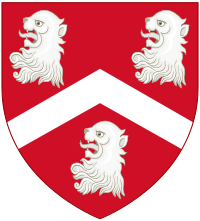Charles Monck, 4th Viscount Monck
This article needs additional citations for verification. (July 2009) |
The Viscount Monck | |
|---|---|
 The Viscount Monck in 1880. | |
| 1st Governor General of Canada | |
| In office 1 July 1867 – 14 November 1868[1] | |
| Monarch | Victoria |
| Prime Minister | John A. Macdonald |
| Prime Minister (United Kingdom) | Earl of Derby Benjamin Disraeli |
| Preceded by | New position |
| Succeeded by | The Lord Lisgar |
| Personal details | |
| Born | Charles Stanley Monck 10 October 1819 Templemore, Ireland |
| Died | 29 November 1894 (aged 75) Enniskerry, Ireland |
| Nationality | British |
| Spouse | Lady Elizabeth Monck (m. 1844; died 1892) |
| Relations | Charles Monck, 1st Viscount Monck (grandfather) Henry Monck, 1st Earl of Rathdowne (uncle) |
Charles Stanley Monck, 4th Viscount Monck GCMG PC (10 October 1819 – 29 November 1894) was a British politician who served as the last governor-general of the Province of Canada and the first Governor General of Canada after Canadian Confederation.
Early life
[edit]
Charles Stanley Monck was born in Templemore, County Tipperary, Ireland. He was the son of Charles Monck and his wife Bridget née Willington. His father was the younger son of Charles Monck, 1st Viscount Monck and the former Anne Quin. After his grandfather's death in 1802, the viscountcy had been inherited by his father's elder brother, Henry Monck, who in 1822 was further created Earl of Rathdowne. However, in 1848, Lord Rathdowne died without male heirs (albeit with many daughters), the earldom became extinct, and Monck's father succeeded as 3rd Viscount. His maternal grandparents were John Willington of Killoskehan Castle in Barnane, and the former Bridget Butler (daughter of Theobald Butler of Knocka Castle in Drom).[citation needed]
Career
[edit]Monck obtained a law degree from Trinity College Dublin. He married his cousin Lady Elizabeth Monck (one of Lord Rathdowne's daughters) in 1844, and in 1849 he inherited his father's title as 4th Viscount Monck. In 1852 he was elected MP for Portsmouth (as an Irish peer, he had no seat in the House of Lords), and from 1855 to 1858 he served as Lord of the Treasury under Lord Palmerston.
Governor General of Canada
[edit]In 1861, he was appointed Governor General of British North America as well as Governor of the Province of Canada. Lord and Lady Monck and their children came to Canada, but they did not remain throughout his term of office as Governor General of Canada. The family resided at Spencerwood in Quebec during most of their stay in Canada.
During this time, the Canadian colonies were beginning to organise themselves into a confederation. The American Civil War had just broken out, and the Trent Affair caused diplomatic tension between the United States and Britain. The Canadian government was eager to gain some measure of independence during this turbulent period. The Quebec Conference, the Charlottetown Conference, and the London Conference, at which the details of confederation were discussed, all took place during Monck's time as governor. Monck supported the idea, and worked closely with John A. Macdonald, George Brown, George-Étienne Cartier, and Étienne-Paschal Taché, who formed the "Great Coalition" in 1864.
In 1866, Monck was created a peer of the United Kingdom with the title Baron Monck, which gave him a seat in the House of Lords. When the Canadian colonies became a semi-independent confederation the next year, Monck became the country's first Governor General. Monck was also responsible for establishing Rideau Hall as the residence of the Governor General in Ottawa.
Later life
[edit]In 1869, Monck was succeeded by Sir John Young (later Lord Lisgar). He returned home to Ireland, where he became Lord Lieutenant of Dublin in 1874.
Personal life
[edit]
On 23 June 1844, he married Lady Elizabeth Louise Mary Monck, his first cousin and the daughter of his uncle Henry, the 2nd Viscount, who had been made Earl of Rathdowne in 1822. Together, they were the parents of two sons and two daughters:[2]
- Hon. Frances Mary Monck (d. 1930), who married the Rev. Richard Aslatt Pearce.[3]
- Hon. Elizabeth Louise Mary Monck (d. 1913), who married John Macdonald Royse.[citation needed]
- Henry Power Charles Stanley Monck, 5th Viscount Monck (1849–1927), who married Lady Edith Caroline Sophia Scott, the fourth daughter of John Scott, 3rd Earl of Clonmell, in 1874.[citation needed]
- Hon. Richard Charles Stanley Mountjoy Monck (1858–1892), who married Alice Ann Lymer in 1879.[citation needed]
Lady Monck died in June 1892, aged 78. He died in November 1894, aged 75.[4]
Arms
[edit]  |
|
References
[edit]- ^ Office of the Governor General of Canada. "History > Former Governors General > The Viscount Monck". Queen's Printer for Canada. Retrieved 4 November 2012.
- ^ Morgan, Henry James, ed. (1903). Types of Canadian Women and of Women who are or have been Connected with Canada. Toronto: Williams Briggs. p. 244.
- ^ http://www.freebmd.org.uk JUN 1888 1a 773 St Geo Han Sq Richard Aslatt Pearce = Frances Monck
- ^ Monet, Jacques (1990). "Monck, Charles Stanley, 4th Viscount Monck". In Halpenny, Francess G (ed.). Dictionary of Canadian Biography. Vol. XII (1891–1900) (online ed.). University of Toronto Press.
- ^ Borrow-Longain, FRSA, FRNS, MRI, Paul ELT (September 2014). "His Excellency The Right Honourable Charles Stanley Monck, 4th Viscount Monck, GCMG, PC Governor General & Commander-in-Chief of Canada" (PDF). Hogtown Heraldry. Vol. 24, no. 3. The Toronto Branch of the Royal Heraldry Society of Canada. p. 7. Retrieved 24 August 2017.
{{cite news}}: CS1 maint: multiple names: authors list (link)
External links
[edit] Media related to Charles Stanley Monck at Wikimedia Commons
Media related to Charles Stanley Monck at Wikimedia Commons- Hansard 1803–2005: contributions in Parliament by the Viscount Monck
- http://www.gg.ca
- Photograph: Governor General Monck in 1864. McCord Museum
- Photograph: Lord Monck, Governor General in 1866. McCord Museum


 French
French Deutsch
Deutsch